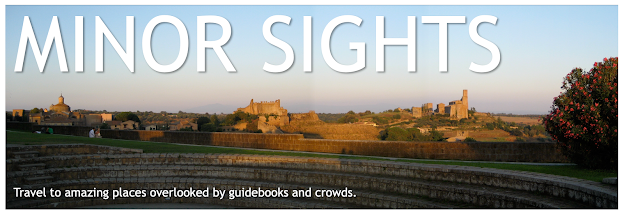 What?
What?A landscaped garden estate just a short boat ride away from Seattle.
Why visit?
Chopping down trees was a profound source of wealth in the Pacific Northwest.
But timber baron Prentice Bloedel turned things around, and used his wealth to plant new trees.
The estate he left behind makes an unexpected and unusual day trip from Seattle.
Where?
On Bainbridge Island, a short ferry ride away from Seattle. Map.
THESE DAYS, SEATTLE likes to position itself as a digital tech hub, Silicon Valley's extension up north, home to Amazon and Microsoft. But the Pacific Northwest's initial fortunes were based on something decidedly more low tech: timber.
 |
| Seattle's high-tech skyline as seen from Bainbridge Island. |
Starting around 1850, timber companies began chopping down trees at a rapid pace. Ginormous fortunes were made, all at the expense of Mother Nature, because 19th century timber barons weren't much into sustainability. You chopped it down, sent the lumber downstream, collected your cash, and moved on. It was a pretty destructive industry, comparable to the much-decried logging done in places like Brazil and Indonesia in our own day and age.
One of these lumber magnates was Julius Bloedel, who set up a business that became one of the world's largest logging operations at the time. In 1929, Julius asked his son Prentice to join the company. Bloedel Jr. initially had other plans- he wanted to be a teacher, and he joined daddy's company rather reluctantly.
Prentice Bloedel recognised raking in the dough was nice, but the business needed a long term view. If you keep on chopping trees down, at some point you're going to run out of trees. In 1938 he started the first reforestation programme, by planting seedlings after the trees had been harvested. He used one of the company's mills to reprocess waste, and turned sawdust into fuel, and accidentally invented something akin to Duraflame logs.
All of this made good business sense- but it wasn't common practice back then and Prentice Bloedel can be credited with pioneering a vision of sustainable forest management (although we doubt they called it by that name back in the 1930's).
In a practice that will be familiar to any corporate raider, Bloedel recognised that scale and synergy was required to stay ahead of the competition, and he masterminded a merger with a large Canadian timber company in 1950. Fed up with the corporate rat race, he dropped out a year later and acquired a piece of land on Bainbridge Island, where he retired with his wife Virginia.
Still only 51 years old, and more than comfortably well-off, the Bloedels turned their property into a garden that struck a balance between the forces of nature and the forces of man. The 150-acre estate opened to the public in 1988 as a public garden and nature reserve.
 |
| Photo credit: Bloedel Reserve website |
Of course the best part of the Bloedel Reserve is to be found outside. There are clearly indicated trails offering you quiet contemplation- the reserve's website talks of 'Strolls for Well-Being'.
There is also a Japanese garden created in the 1950s with help from renowned Japanese landscaping architects. Prentice had a thing for Japanese landscaping: he also provided capital for the Japanese Garden in Seattle (another Minor Sight.)
All in all, the most important reason to come here is to peace out. Even to those who don't have Bloedel-sized heaps of moolah to ensure a leisurely life, the garden they left us offers a moment a quiet respite away from a high-tech 21st century.
Getting there:
It is possible to get to Bainbridge island by car, but why would you?
Coming from Seattle, a trip on one of the iconic State ferries is a lot more fun, and a lot faster to boot. On a good day, this voyage offers great views of the city, Mt Rainier, and the Olympics.
Once you land at the island's ferry dock, it is about a 20 minute drive to Bloedel Reserve.
The estate is open Tuesday to Sunday, and charges an entrance fee.
 |
| Nothing says Seattle like a view of Mt Rainier on a clear day. |
Useful links:
The Bloedel Reserve has an official website.
History Link Biography of Prentice Bloedel
The Matisse, and how it ended.








Comments
Post a Comment
Have you been here? Or are you planning to go? Either way, we would love to hear about it.